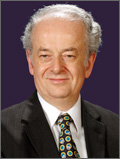215th ECS Meeting | Vienna, Austria | May 25, 2009
Quantum Cascade Lasers for the Mid- to Far-Infrared: Band-Structure Engineering, Beam Engineeringspan and Applications
In his plenary talk Federico Capasso will trace the path from the invention to exciting advances in the physics, applications and commercialization of the quantum cascade lasers a revolutionary light source which covers the mid- and far-ir spectrum and is broadly impacting sensing, spectroscopy and sub-wavelength photonics.
The Quantum Cascade Laser (QCL) has emerged as the laser of choice for photonics and spectroscopy in the mid-infrared and in the far infrared, covering the range from 3 to 300 microns in wavelength, due to its unique wavelength agility and large “design space” that allows one to tailor its performance at will for a wide range of applications. These include single mode broadly tunable lasers for chemical sensing and trace gas analysis at parts per billion in volume; compact, chip-scale, broadband spectrometers with performance already comparable to state of the art Fourier-Transform-Infrared-Spectrometers; high power continuous wave room temperature devices for military applications etc. Important commercial developments will be discussed. New functionalities have been demonstrated by integrating on the facets of QCLs sub-wavelength plasmonic nanostructures that have led to highly collimated beams by achieving a dramatic reduction of the beam divergence for LIDAR applications, unprecedented control of the polarization and ultrahigh intensity nanoscale size spots in the near field for high resolution chemical imaging.
Federico Capasso is the Robert L. Wallace Professor of Applied Physics at Harvard University, which he joined in 2003 after a 27year career at Bell Labs. He holds a Doctor of Physics degree from Rome University. His research includes band-structure engineering of novel devices/material, nanophotonics and quantum electrodynamics.
He has co-authored over 300 papers and holds over 65 US patents. He is a member of the National Academy of Sciences, the National Academy of Engineering, and a Fellow of the American Academy of Arts and Sciences. His awards include the King Faisal International Prize for Science, the American Physical Society Arthur Schawlow Prize, the IEEE Edison Medal, the IEEE Streifer Award, the Wetherill Medal of the Franklin Institute, the OSA Wood prize, the Rank Prize in Optoelectronics, the Material Research Society Medal, the IEEE Sarnoff Award, the Welker Medal, the Duddell Medal and Prize of the Institute of Physics, the Newcomb Cleveland Prize.
